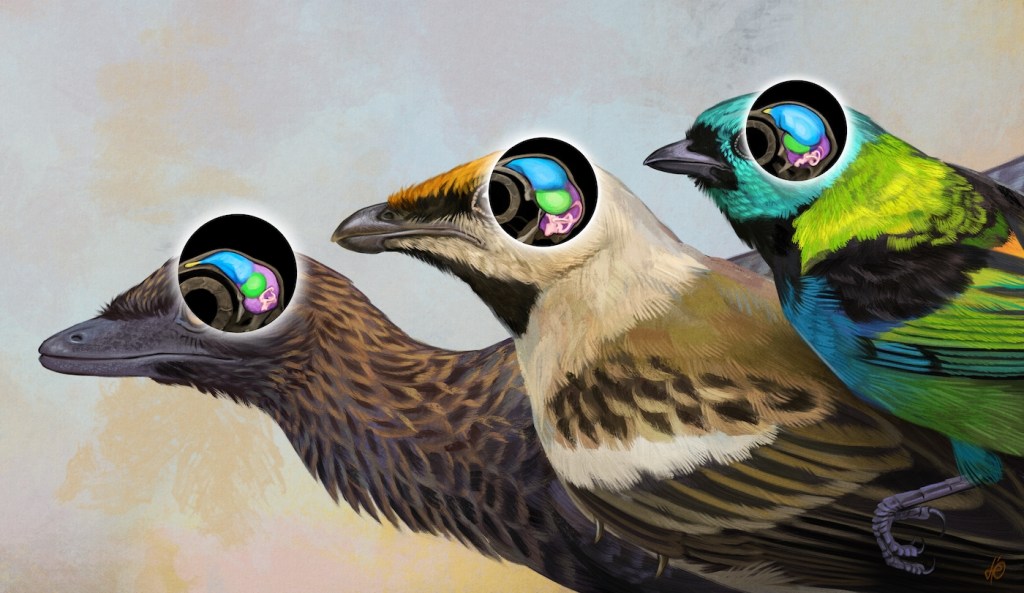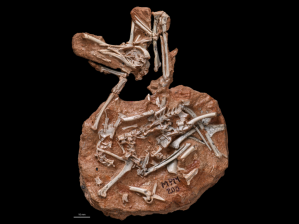Ancient Bird Fossil Offers Clues Into How Bird Brains Evolved
9:31 minutes

Archaeopteryx is the earliest bird-like dinosaur that we know of. It lived 150 million years ago, but researchers don’t know much about how the bird brain evolved from then to now.

An 80 million-year-old bird from the Mesozoic Era is now helping fill in the blanks. It’s called Navaornis hestiae. Researchers uncovered a fossil of this species, which was previously unknown to science, in Brazil in 2016. That specimen has a remarkably well-preserved skull, which a team of paleontologists used to digitally reconstruct the bird’s brain. The researchers recently reported their findings in the journal Nature.
Ira talks with a lead author of the study, Dr. Luis Chiappe, a paleontologist and curator at the Natural History Museum of Los Angeles County in California.
Invest in quality science journalism by making a donation to Science Friday.
Dr. Luis Chiappe is a paleontologist and curator at the Natural History Museum of Los Angeles County in Los Angeles, California.
IRA FLATOW: Archaeopteryx is the earliest bird-like dinosaur that we know of. It lived 150 million years ago, but from then to now, well, researchers don’t know much about how the bird brain evolved. There’s a gap.
But now, an 80 million year old bird fossil from the Mesozoic era is helping fill in this gap. It has a remarkably preserved skull, which scientists use to digitally reconstruct the bird’s brain. Joining me is a lead author on this study, Dr. Luis Chiappe, a paleontologist at the Natural History Museum of Los Angeles County in California. Welcome to Science Friday.
LUIS CHIAPPE: Thank you. Pleased to be here.
IRA FLATOW: Nice to have you. Tell us about this ancient bird. What’s its name? Where did it live?
LUIS CHIAPPE: The name is Navaornis hestiae, and as you pointed out, it lived 80 million years ago in what is now Southern Brazil, not far from the city of Sao Paulo. It looked very much like a plover, if you want. But it was not at all a plover. It belongs to a group of archaic birds called enantiornithes that were widespread during the Cretaceous period.
They lived all around the world. But Navaornis, like other enantiornithes, was a very capable flier. And it had roughly the size of a plover. And what is surprising of this animal is how much the skull looks like a modern skull, like the skull of a plover.
IRA FLATOW: Wow. So, but is it a direct descendant, then?
LUIS CHIAPPE: It is not. I mean, all enantiornithes died out with the mass extinction at the end of the Cretaceous, the same mass extinction that killed dinosaurs like T-Rex and triceratops 66 million years ago.
IRA FLATOW: So then why is this bird important for you to study?
LUIS CHIAPPE: Two pieces of the story, if you want, are very important. On the one hand, as you pointed out in your introduction, the brain of this animal that we were able to reconstruct falls between Archaeopteryx and that of a modern bird. So it really fills a very long gap that existed before.
And on the other hand, what I think is really surprising, and it was unexpected, is that the geometry of the skull of this animal– by that I mean it has a slender bill. It has big eye sockets. It has a vaulted basicranium. That’s the part of the skull that contains the brain. They look very, very much like that of a modern bird.
And yet, the bones that made up this skull are primitive. They have primitive features. They’re very dinosaurian-looking. So in a sense, it’s like if you were to be building the Empire State Building with Adobe bricks.
IRA FLATOW: [LAUGHING]
LUIS CHIAPPE: Yeah, I mean, surprising, right, and unexpected. This is a great example of what we call convergent evolution. So in this case, Navaornis and modern birds had a common ancestor that is at least 130 million years old. So those lineages have been separated for 130 million years. And yet, they converged in having the same geometry of the skull.
IRA FLATOW: That’s interesting. As you say, that bird did not survive, but the other birds did.
LUIS CHIAPPE: The modern birds did, of course.
IRA FLATOW: The modern birds did. And so this fossil’s lineage, which is extinct, developed similar skull features to modern birds separately.
LUIS CHIAPPE: Exactly.
IRA FLATOW: Wow. That is surprising.
LUIS CHIAPPE: Yeah, and unexpected. And not just similar. I mean, the similarity is remarkable. I mean, when you look at, say, the skull of an animal– I’m using a plover, because roughly that size, or a pigeon– and you put that skull on one next to the other, unless you’re looking into the details of the bones, those skulls look remarkably similar.
IRA FLATOW: OK, so now that we’ve met this bird, how did you go about reconstructing its brain?
LUIS CHIAPPE: The way we reconstructed the brain is you use what is called a micro-CT, a micro Computed Tomographer. It’s very much like an MRI, but much more precise. And it’s an X-ray based machine.
So you have a bunch of X-ray slices, that are very thin, of the fossil. And then with software, you stitch them all together. And you create a three dimensional rendering, a three dimensional image, of the skull. And therefore, you could look into the internal portions of the skull without breaking it.
And you could reconstruct what is the void of the brain preserved in the fossil. The brain is not preserved anymore, but you could at least reconstruct the void. That’s where you do comparative anatomy. And you look at the brain of modern birds and the brain of other animals to be able to identify where the optic lobes are, where the cerebellum is, and so on.
IRA FLATOW: Interesting. So what elements of this fossil, then, were similar to the earliest birds of those alive today?
LUIS CHIAPPE: Well, what you have, for example, that’s most remarkable in terms of the brain is that the brain is rotated. That means that in most modern birds, the connection between the brain and the spinal cord comes from the bottom of the skull, not from the back of the skull, the way it does, say, in a typical dinosaur, or in Archaeopteryx.
So that is an advanced feature that you see, a modern feature that you see in the brain. Nonetheless, when you look at, say, the size of the cerebellum, the size of the other components of the brain, they look more primitive. We were able to reconstruct the inner ear of the bird. And this is important because it’s a very critical sensory organ, and particularly for an aerial animal that has to navigate in three dimensions. And the inner ear of Navaornis is also very modern in appearance.
IRA FLATOW: Wow, so there are modern elements in this bird.
LUIS CHIAPPE: Yeah, there’s definitely modern elements. And there are also archaic elements. And that’s why this is somewhat in between.
IRA FLATOW: You mentioned about how surprising, how this bird looked so modern. Did this fossil challenge what you thought you knew about bird brain evolution?
LUIS CHIAPPE: I think it challenged what we knew about the convergent evolution that we see in the shape of the skull. I think that it also surprises– to me, it was surprising to have an inner ear that was so modern looking. I didn’t expect that.
But what was more unexpected was really the fact that you have this modern looking skull made up of these very primitive bones. And that was completely unexpected. And it may be telling you that at the time of constructing a modern avian skull, the skull of a modern bird, you don’t have too many ways of putting together a modern avian skull, and that evolution used the tools that it had at the time and built a modern one based on basic bricks.
IRA FLATOW: I mean, does it ever get old, studying creatures that lived millions and millions of years ago?
LUIS CHIAPPE: No, no. I have done– I’ve worked on early bird evolution for nearly 40 years. And this one was a mind blowing discovery. But I’m sure that many others are going to come in the future. I hope to see them.
IRA FLATOW: Where does this rank? Does this make it into the top five fossils of your career?
LUIS CHIAPPE: Definitely, I think so, undoubtedly.
IRA FLATOW: What number would you put it?
LUIS CHIAPPE: Well, I have found some very cool fossils during my lifetime. And I haven’t found this one. It was found by an amateur paleontologist in Brazil. But I think that this is really one of those remarkable fossils. It’s the best preserved avian skull in the Mesozoic worldwide. It’s just beautifully preserved.
IRA FLATOW: Could we actually see it ourselves at a museum someplace?
LUIS CHIAPPE: It’s in Brazil. It’s at a museum, a small museum in Brazil in a city called Marilia. But you can see pictures.
IRA FLATOW: Yeah, we have pictures. Dr. Chiappe, I want to thank you for sharing your knowledge and your discoveries.
LUIS CHIAPPE: Thank you so much. Thank you for having me, Ira.
IRA FLATOW: You’re welcome. Dr. Luis Chiappe is a paleontologist at the Natural History Museum of Los Angeles County in California.
Copyright © 2024 Science Friday Initiative. All rights reserved. Science Friday transcripts are produced on a tight deadline by 3Play Media. Fidelity to the original aired/published audio or video file might vary, and text might be updated or amended in the future. For the authoritative record of Science Friday’s programming, please visit the original aired/published recording. For terms of use and more information, visit our policies pages at http://www.sciencefriday.com/about/policies/
Rasha Aridi is a producer for Science Friday and the inaugural Outrider/Burroughs Wellcome Fund Fellow. She loves stories about weird critters, science adventures, and the intersection of science and history.
Ira Flatow is the founder and host of Science Friday. His green thumb has revived many an office plant at death’s door.